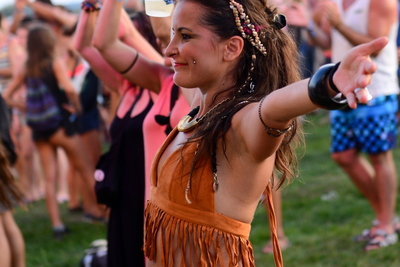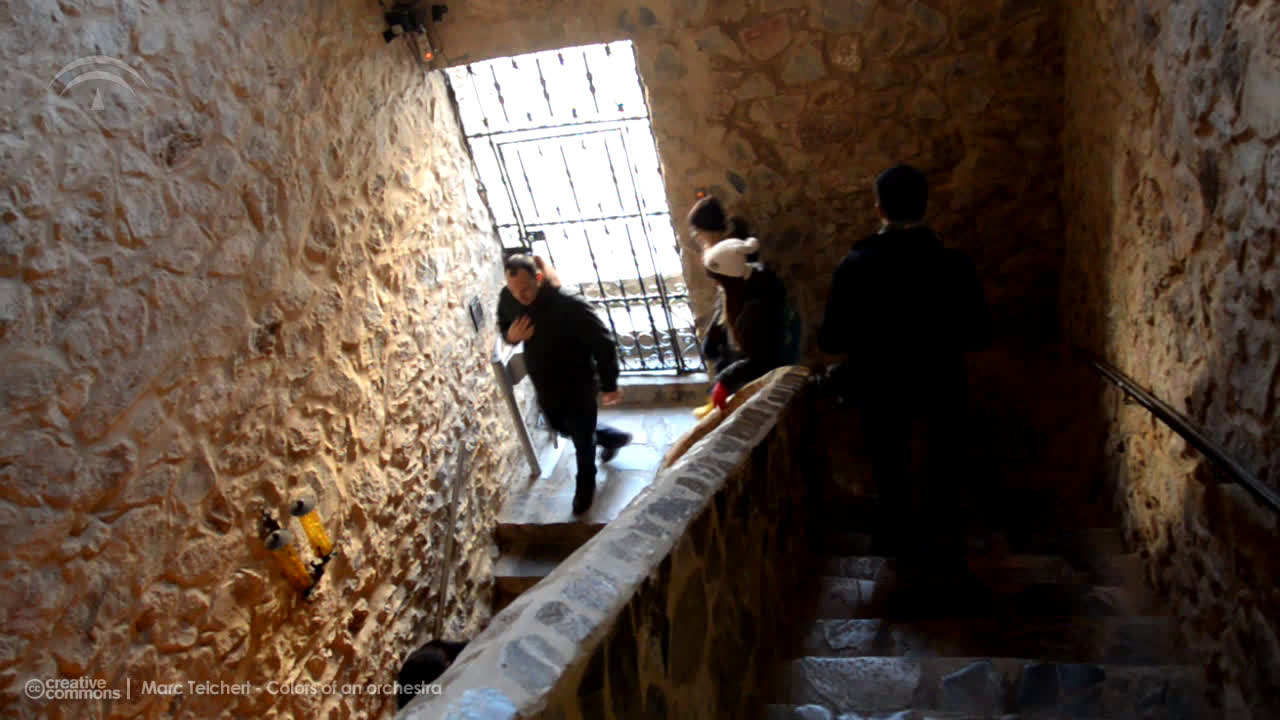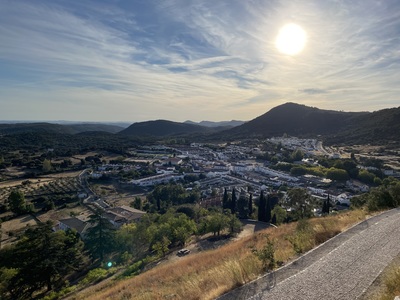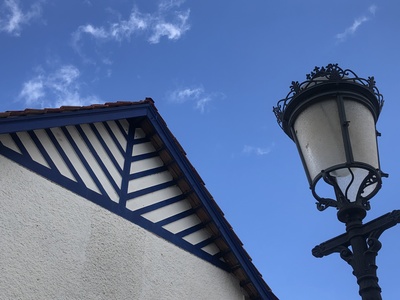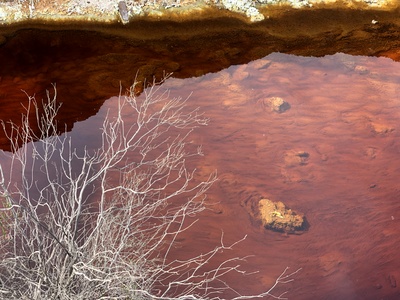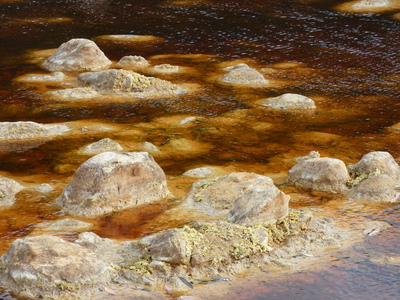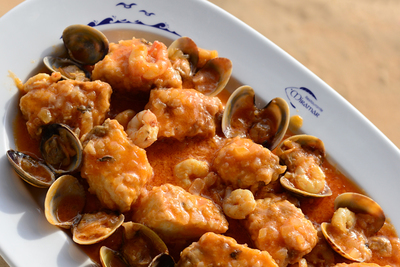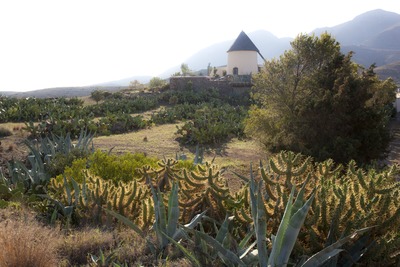In search of the English legacy in the province of Huelva through the Rio Tinto

We can follow the many traces that the British left in the province of Huelva with the Rio Tinto as the common thread. A really unusual trip from the Riotinto Mines to Punta Umbría to find out more about the time when the mines were assigned to the Rio Tinto Company.
When in 1873 the British company "Rio Tinto Company Limited" was awarded the rights to exploit the deposits in the Riotinto Mines, one of the most valuable and prolific mineral deposits in what was known as the Iberian Pyrite Belt, life changed forever not only in the region but throughout the province of Huelva. It is just as true to say that mining activity had been undertaken here for more than five thousand years, since the Chalcolithic Age involving the Tartessians, Phoenicians, Iberians, Romans, Visigoths, Moors and Castilians. But the arrival of the new methods of the Industrial Revolution from the United Kingdom modified this territory almost entirely. The British took advantage of the Tinto river basin to undertake their activity and transport wagons full of copper and other minerals to their country. They stayed in Huelva for several decades and left their mark on towns and cities. Nowadays the English legacy, both tangible and intangible, is immense, since it penetrated to the very depths of the territory and society in Huelva.
This will be the essence of my trip to Huelva, unlike those made on other occasions that focussed on holiday and family travel to the beaches of El Rompido, my own personal paradise. The trip to this part of the province of Huelva follows the reddish tints of the Río Tinto river, with visits to mining deposits and a search for scenarios denoting the presence of the British who mined the area, built Victorian country houses, brought sports that were previously unknown in Spain, like football and tennis, and each year celebrated the queen's birthday to help them feel right at home, but with the advantage of the extraordinary climate in Huelva.
Si I drove to the Riotinto Mines in my car. I had a notebook full of notes, with underlined texts and, above all, so many questions. And I converted a green room in the Hostal Atalaya, a few steps from the Mining Museum and a Presbyterian church with a typical Scottish façade, into my first operational base.
The towns of Minas de Riotinto and Nerva are the focal point for the majority of the mining operations and for this British heritage. In an almost Martian landscape bathed by a river as red as blood (resulting from the oxide and sulphide sediments brought down from its source), a series of towns with white-washed walls appear on the map. And there is so much to see that everything needs to be orderly. Thanks to the efforts of the Río Tinto Foundation to preserve and make the area know, 1987 saw the foundation of the Riotinto Mining Park, where all this natural, historical and cultural wealth was turned into tourist activity to highlight the importance of this extraordinary legacy.
I used the www.parquemineroderiotinto.es website to buy tickets and choose the best times to make all the visits I was interested in with regard to the past and present of this extraordinary mining area. I found five of them with combined admission and packages that helped me get organised. The following were ideal, and in this order: Mining Museum + Peña de Hierro + Tourist Mining Railway + Casa 21. The price is €23, which for everything you get is really not bad at all.
The Mining Museum in the town of Minas de Riotinto, which was until not long ago an English hospital for the workers of the Rio Tinto Company Limited, got me started and helped me understand why there is so much wealth under the ground in this part of Huelva. They also helped me learn about other civilisations that have passed through here, with special mention for archaeological treasures from the Neolithic and Roman eras, as well as the recreation of a Roman mine illuminated by light shafts. But, without a doubt, what I liked most were the old locomotives and wagons that have been kept in a room that recreates an old railway station. Especially a sumptuous railway wagon originally designed for a trip that Queen Victoria was supposed to make to India when it was an English colony and that was brought here instead to be used by the most prominent workers of the Rio Tinto Company as well as special guests who travelled along the line that went as far as the port of Huelva.
From here I then made my next visit to Nerva, a town near the Riotinto mines. Peña de Hierro is not only the source of the Río Tinto, but also one of the mines or open casts when the hillside has been terraced and you can see all the colours provided by the ore. To get the best view, you need to put on a miner's helmet and walk along a dark two-hundred metre gallery. This is when I imagined my young son walking excitedly with his helmet on, because he really loves places like this.
Nerva is not only Peña de Hierro. It is also worth going down the narrow slope to photograph the Río Tinto river. And you should also take a stroll around the town where you can still see traces of its British past in some of the façades of buildings like the Círculo Mercantil. There is clear evidence of the British influence in every street. Especially in the old railway station turned into one of the best terraced restaurants in the area, Casa Idolina, a truly successful adaptation in a place where you still seem to hear the locomotives letting off steam.
The package purchased in the Mining Park included a third visit that took me to the Bella Vista neighbourhood at one end of the Riotinto Mines. Bella Vista was an English neighbourhood, a true garden city with large houses destined for the most prominent members of the Riotinto Company Limited. The interior of one of the houses that belonged to one of the British engineers, Casa 21, can be visited and the furnishings make it look just like a little piece of England right in the heart of the province of Huelva.
Many more Victorian houses have survived in the surrounding area, as well as a church and the oldest tennis courts to be found in Spain. Because you should not forget that, although football was first played in Minas de Riotinto, tennis also became fashionable here.
Bella Vista is the most easily recognisable symbol of the British colony, of that legacy that I was looking for throughout my trip. As I walked through the streets, it was easy for me to imagine people enjoying their five o'clock tea in the living rooms of these houses using Bournemouth crockery and streets full of people celebrating Queen Victoria's birthday.
A train was waiting for me at the old station at 5.30pm (you can book the train time on the Mining Park website when buying tickets, as you can with Peña de Hierro and Corta Atalaya). And with the British punctuality we have come to expect, I started a journey of twenty-two kilometres (eleven kilometres each way) along a track that has been recovered and was once part of one of the first railway lines in Spain and which linked Minas de Riotinto with the mineral dock in the city of Huelva.
The tourist railway goes as far as the Los Frailes station, passing by a river reddened by iron oxide and mines with buildings and machinery that seem to have been frozen in time. And ghost railway halts that look like the English left in rather a hurry. What remains are dozens of wagons and locomotives that have been eaten away by rust, time and nostalgia.
The last visit of my day's visits included in the package organised by the Riotinto Mining Park took me to Corta Atalaya, which was the largest open cast mine not only in Spain but in the world. It is so colossal even a train that was passing along one of the lower terraces and stopped there forever looks just like a miniature.
EL CAMPILLO AND ZALAMEA LA REAL
After two nights in Minas de Riotinto, the time came to continue my journey and visit more places that remind us of their mining and English past. Just four kilometres away, I came to the small railway station of El Campillo where I saw an old Class K locomotive in a park known as Los Cipreses, which was purchased by the Rio Tinto Company Limited in 1907 to become part of the Corta Atalaya open cast mine.
I hardly had time to put my seatbelt on when we reached Zalamea la Real, with whitewashed house and the Church of Nuestra Señora de la Asunción ( 16th century) shining on the horizon. Before entering the town, on the left hand side, I noticed another railway station that looked decidedly English. But just as with Casa Idolina in Nerva, it is now a delightful restaurant with a very appropriate name: "El andén de la estación” ("The Station Platform").
From Zalamea la Real to the village of El Pozuelo takes just fifteen minutes, and I went to find something that had nothing to do with what my trip had been up to now. Because there you will find one of the most important groups of dolmens in Andalusia. An extraordinary Neolithic necropolis with eleven corridor dolmens scattered around the countryside. I walked up to one of these tombs that are said to date back to 2500-3000 BC with no more company than that of a donkey braying from a nearby farm.
It makes quite an impact when you visit treasures of this type completely alone. A sign that there are still many places where tourism has barely arrived.
THE RÍO TINTO VÍA VERDE IN BERROCAL
Part of the railway line in the Río Tinto river basin has been converted into a vía verde (rail trail) and one of the best hiking routes in the province of Huelva. At least in the Berrocal area, where they have converted five kilometres next to the old railway line where, ideal for hiking and cycling in the company of this unusual river. Old buildings appear along the route, including railways halts in a ruinous state, bridges that nobody crosses and part of this forgotten section along which we walk.
From Berrocal to Los Frailes is quite an adventure. And a chance to get a closer look at the Carmesí River. You could go almost all the way to Huelva but those of us, like, who do not have the time, choose just a few kilometres to explore on foot the history of what would have been one of the most formidable train journeys at that time.
We recommend you leave your vehicle in the car park just past the bridge that separates Berrocal from the road to Zalamea la Real. And really enjoy this little journey back in time.
VALVERDE DEL CAMINO
The next stop was Valverde del Camino, a crossroads since Roman times (as can be seen in a preserved section of the road), which nowadays is renowned for its cowboy boots and crafts. Even though it is one of the most important places where the Anglo-Saxon legacy is not just a legend, but truly embodied in the appearance of this municipal district of more than ten thousand inhabitants.
This is understood by the fact at the first place that travellers come across is an English mansion. Just like that. Casa Dirección would be the finest that the United Alkali Company Limited built here. A place where the highest official in the mining and railway company lived with his family, enjoying all the luxuries and comforts possible. It is located just like a watchtower where the arrival of copper and other materials could be monitored, as what is left of the workshops (now the venue for a Trade Fair) is nearby, as is the old station (now a Music Conservatory) and the head offices.
I was able to visit this house free of charge and learned so much about effect the English had on this province. Just by climbing the wooden stairs and admiring the rooms and black & white photos I was taken on a journey back to that era.
Right next door is another Casa Direcciónbut this has nothing to do with the mansion but has been converted into one of the most successful and innovative restaurants in Huelva. The Chef, José Duque, serves delicious fusion cuisine that makes the best of the extraordinary local produce. This is one of those places where the kilometres you have to travel are truly justified.
A stroll through the white streets, admiring the Church of Nuestra Señora del Reposo and a short climb up to the Chapel of El Santo with a magnificent Neo-Baroque façade meant that the journey involved much more than industrial heritage.
NIEBLA
I drove down to Villarrasa to take a look at the Puente Gadea Bridge and enjoy the Río Tinto for the umpteenth time. And this would happen yet a gain just a few minutes later when I crossed the Puente de Niebla bridge, whose Roman origin can be seen in the pointed arches. This led to a walled town with features left by Andalusians and all the civilisations that have used this as a stronghold.
Two kilometres of walls, five gates and fifty towers, enclose a peaceful town with harmonious façades and, of course, a castle. But there is much more to this fortress in Niebla, better known as the castle of the Guzmanes after its first inhabitants, the Dukes of Media Sidonia. This is an authentic mediaeval fortress built to defend the town right to the end. A visit to the interior only costs €4 and you can walk around the battlements, visit some of the rooms and delve into its rich history.
Every summer it is the venue for the Castillo de Niebla Theatre and Dance Festival, which held its thirty-sixth edition in 2021, making it one of Andalusia's most important cultural events.
But Niebla is not just about a castle and its walls, which are already quite a lot. A walk along the Calle Siete Revueltas took me to the Plaza Santa María with bells ringing in a tower that reminded me much of a minaret rather than a belfry. Nevertheless, the bells were ringing in the church of Santa María de la Granada, which had been the town's main mosque during the Moorish era when the town was the head of the powerful Kingdom of Taifas. Proof of this are the horseshoe arches where the church is access through a small patio.
Santa Maria de la Granada is one of the town's greatest architectural treasures. But there is a younger sister, the Church of San Martín, next to the Puerta del Socorro gate, providing one of Niebla's most memorable images. It had previously been a mosque. It had even been a synagogue since the reign of Alfonso X as a gift to the Jewish citizens who lived in this walled town. Today it appears as a series of fragments that create a panorama in the reddish light from the setting sun in the late evening.
Leaving the more historical part of Niebla behind and returning to the Anglo-Saxon footprint that is evident throughout province of Huelva, as you pass through the Puerta del Buey gate you come to an old metal railway bridge that crosses the Río Tinto. It was designed by the British engineer, George Barclay Bruce, and it is 140 metres long. It remained in operation from 1875 to 1984 and it was one of eight bridges built along the railway line between Minas de Riotinto and the city of Huelva.
After a wonderful fry-up for dinner in Casa Ramos, I spent the night at the Finca Real de Niebla, without doubt the best rural accommodation in the town. With spacious rooms, gardens, a swimming pool and all the comforts, it could well be considered an ideal base to explore the province.
DOLMEN DE SOTO (TRIGUEROS)
On a foggy morning I continued my journey from Niebla. The walls were barely visible, and a delicious, traditional bread with tomato and Extra Virgen Olive Oil seemed the best start to the day.
On the day I was to arrive, just like the ore used to, in the city of Huelva, I made a stop in Trigueros to search the countryside for a megalithic monument, Huelva's Stonehenge. On land in an area designated as La Lobita, there is a 21-metre long dolmen passage. The Soto dolmen, named after its discoverer in the 1920s, claims to be the largest of its kind in Europe. There are petroglyphs in the interior and its location is by no means accidental. At each equinox the first rays of sun enter the passage for a few minutes at sunrise. This is yet another example of the astronomical knowledge of Neolithic settlers in 3,000 BC.
HUELVA, THE END OF THE JOURNEY FOR THE ORE
Just after the Río Tinto meets the salty water and loses its peculiar colour in San Juan del Puerto, I finally reached the city of Huelva. With the intention of making it one of the great European ports, the English owners of the Rio Tinto Company Limited added a number of features that are now some of the hallmarks of the city and can be found at the confluence of the Tinto and Odiel rivers. So of course, I set off to find them.
In the working-class neighbourhood called "Reina Victoria", this British company wished to introduce the garden city concept, and for their workers to live there. The name was in honour of the Queen of Spain and consort of Alfonso XIII, Victoria de Battenberg. To achieve this they built a chequerboard with a series of houses that are a blend of colonial and purely eclectic. The colourful roofs, the wooden frameworks on the house fronts and the gardens lead to what is still today one of the most privileged scenarios in the city of Huelva.
Just a short distance away, passing by the old Guard's House (now a restaurant) and the barred fence with a sign indicating Rio Tinto Company Limited, I came across yet another icon from the British era, the Casa Colón. It was built at the end of the 19th century as a top-class hotel in a city that they aimed to project as a great port from which they would export thousands of tons of copper and other metals required to bring about the Industrial Revolution worldwide. For this they needed a place to accommodate great personalities, where those responsible for running the main mining company could live, and while they were at it, some where to celebrate the 4th Centenary of the Discovery of America with a certain amount of pomp.
It is less than two kilometres from here to the waters of the Odiel River and the last stop for the goods brought from the mines by train. This is the Tinto Quay, over 1,200 metres long, 500 of which are over the estuary itself, and from where British ships transported their cargo all over the world, and not just to England.
This metallic structure was built between 1874 and 1876 and was a model civil engineering project in Spain. The wagons loading cargo onto the ships are no longer there, but it is now an attraction of residents of Huelva and visitors who now stroll along the quay and enjoy some of the finest sunsets to be seen in the province.
Without waiting for the sunset, I had another delicious encounter with Huelva prawns, seafood and rice with king prawns at the Restaurante Peix which is located in the Nuevo Estadio Colombino, where the Recreativo de Huelva football team play their home matches. I really ought to say that this is the oldest football club in Spain, and was founded by English residents on 23 December 1889, precisely here in the Casa Colón. So, in one way or another we can see that British circle has never closed since this is just one more example of the significance of the British people who came to Huelva to exploit the underground wealth in the Minas de Riotinto and while they were at it, transformed the area forever.
PUNTA UMBRÍA
Here I could have brought my journey to an end, as happened with the copper, iron, zinc and sulphur, when I reached the city of Huelva. But there was still something else for me to do. And that was to visit Punta Umbría, famous for its kilometre-long beaches and known as "Casa de los Ingleses" (Home of the English). You are probably wondering what Punta Umbría has to do with the British legacy. A lot. Really. Punta Umbría was one of the places where, sine the end of the 19th century, the English residents came to escape from polluted air of the mines and to enjoy the clear blue skies, the salty water and the beach.
They actually built wooden houses on stilts very close to the sea. And one of these can be visited, the "Casa Museo de los Ingleses" at 11, Avenida de Huelva, just behind the Hotel Pato Amarillo. This is the hotel where I spent the last night of my journey, inspired by the ocean from a beautiful room on the seventh floor.
ODIEL MARSHLANDS
The very next morning I started my long journey home. I set off early, because it is better that way and I had time to stop in the Odiel marshlands, a natural area spreading out over a great extent of sea marshes. With hundreds of flamencos calling out on the horizon. And other endangered species like spoonbills that gather on what is know as the Isla de Enmedio, a nature reserve that attracts both serious ornithologists and amateurs like me who never leaves home without taking a pair of binoculars and several batteries for my camera.
In this extraordinary birdlife refuge, there are trails and lookout points where you can photograph or simply enjoy the beauty while remaining oblivious to the hustle and bustle of the city of Huelva.
And so ended a four-day trip where my search for the Río Tinto and the English took to me to so many delightful corners of the province of Huelva. And I know for sure that this will not end here!
José Miguel Redondo (Sele)
Author of the www.elrincondesele.com travel blog

